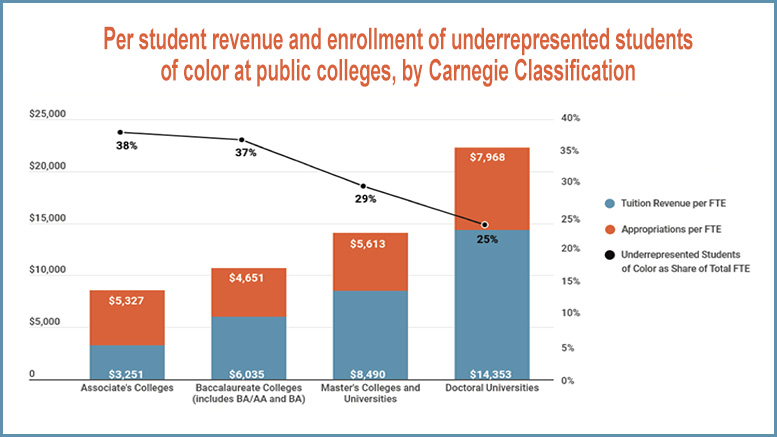If state and federal policymakers want to increase college completion rates among minority students, increasing funding for community colleges and regional universities is a good place to start, according to a new brief from The Institute for College Access & Success (TICAS).
Racial disparities in completion are due, in part, to the fact that public colleges, which disproportionately enroll underrepresented students of color, receive less funding and have lower graduation rates, the brief said. TICAS found that community colleges and regional universities — which enroll more diverse student bodies — both receive less state funding and charge lower tuition.
“As a result, public colleges with the fewest resources serve the most vulnerable students, which drives persistent gaps in educational attainment by race and income,” it said.
Half of underrepresented students of color enroll at community colleges, which receive less than $9,000 in state and tuition revenue per student and collectively have a graduation rate of 25 percent, TICAS said. Compare that to public doctoral institutions, where a quarter of these students enroll and they receive more than $22,000 in state and tuition revenue and graduate two-thirds of their students.
Even though community colleges are affordable, many of their students are challenged with paying for other college costs, such as books, supplies and living expenses — plus they often work part time or full time and are balancing family life.
Three ways to foster change
TICAS has three recommendations to change the situation. First, policymakers should gather better data and track changes over time to more effectively close equity gaps.
“Congress should require states to annually analyze spending and attainment patterns for students of color and other disadvantaged students,” the brief said. Where economic or racial disparities are found, states should provide a plan to address them, it added.
States also can better target state funds based on need, TICAS said.
“While need-based state grant aid is one key to reducing students’ need to borrow, in 2016-17, 24 percent of state grant aid dollars were allocated to undergraduate students without regard to their financial circumstances,” it said.
More than half of underrepresented students of color come from families earning less than $30,000 a year, according to TICAS. To pay for college without loans, these students would have to dedicate half their income to pay to attend a community college even after receiving grant aid.
The final recommendation is to create a new federal-state partnership to increase affordability, attainment and equity. Congress should provide new investments in higher education to ensure that states maintain and increase their own investment in public colleges, with a focus on maintaining or lowering the net price of public college for low- and moderate-income students, TICAS said.

